The Bulldozer Review: AMD FX-8150 Tested
by Anand Lal Shimpi on October 12, 2011 1:27 AM ESTThe Test
To keep the review length manageable we're presenting a subset of our results here. For all benchmark results and even more comparisons be sure to use our performance comparison tool: Bench.
| Motherboard: |
ASUS P8Z68-V Pro (Intel Z68) ASUS Crosshair V Formula (AMD 990FX) |
| Hard Disk: |
Intel X25-M SSD (80GB) Crucial RealSSD C300 |
| Memory: | 2 x 4GB G.Skill Ripjaws X DDR3-1600 9-9-9-20 |
| Video Card: | ATI Radeon HD 5870 (Windows 7) |
| Video Drivers: | AMD Catalyst 11.10 Beta (Windows 7) |
| Desktop Resolution: | 1920 x 1200 |
| OS: | Windows 7 x64 |
Windows 7 Application Performance
3dsmax 9
Today's desktop processors are more than fast enough to do professional level 3D rendering at home. To look at performance under 3dsmax we ran the SPECapc 3dsmax 8 benchmark (only the CPU rendering tests) under 3dsmax 9 SP1. The results reported are the rendering composite scores.

As our first heavily threaded, predominantly FP workload we see the FX-8150 come out swinging. A tangible upgrade from the Phenom II X6, the 8150 is hot on the heelds of the Core i5 2400, however it is unable to compete with the 2500K and 2600K.
Cinebench R10 & 11.5
Created by the Cinema 4D folks we have Cinebench, a popular 3D rendering benchmark that gives us both single and multi-threaded 3D rendering results.
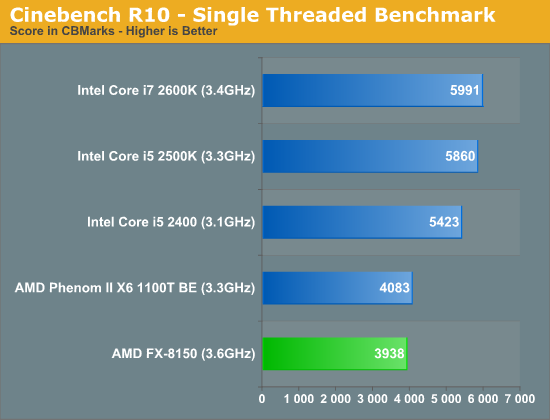
As I alluded to earlier, single threaded performance is going to be a bit of a disappointment with Bulldozer and here you get the first dose of reality. Even considering its clock speed and Turbo Core advantage, the FX-8150 is slower than the Phenom II X6 1100T. Intel's Core i5 2500K delivers nearly 50% better single threaded performance here than the FX-8150.
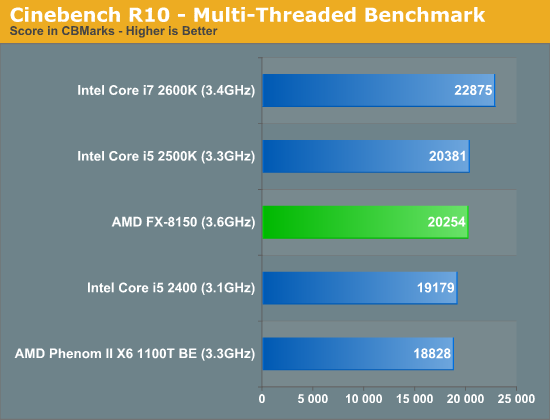
Crank up the threads and the FX-8150 shines, finally tying the 2500K at a comparable price point.
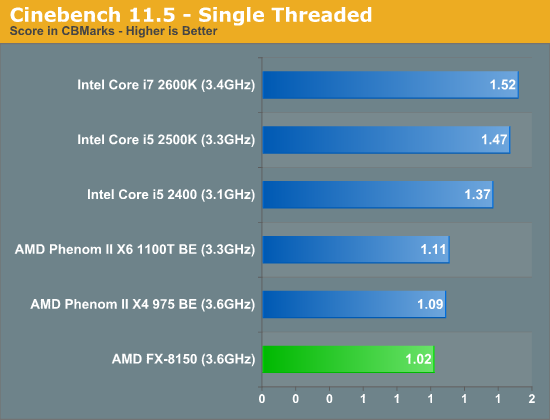
Even with more modern workloads, the FX-8150 isn't able to compete in single threaded speed. Here the 2500K is 44% faster.
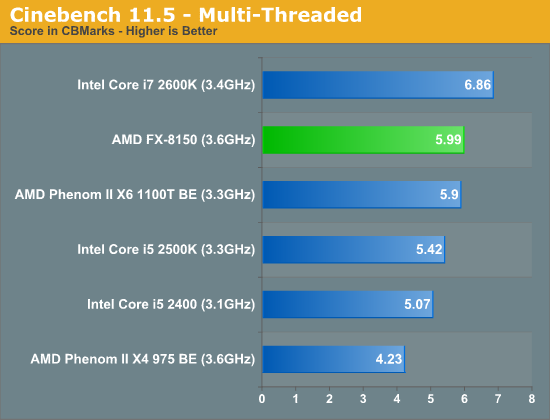
Modern multithreaded workloads however do quite well on Bulldozer. The gains over the old Phenom II X6 1100T are unfortunately not as large as we would expect them to be.
7-Zip Benchmark
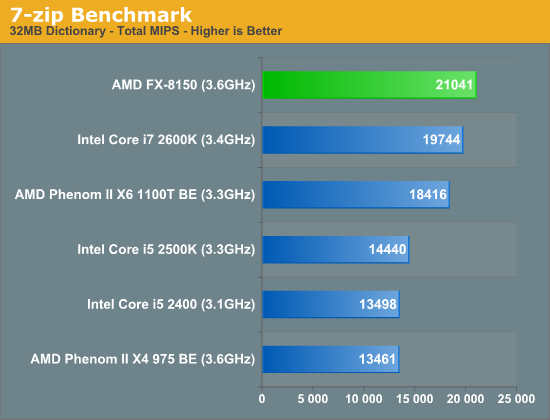
Heavily threaded workloads obviously do well on the FX series parts, here in our 7-zip test the FX-8150 is actually faster than Intel's fastest Sandy Bridge.
PAR2 Benchmark
Par2 is an application used for reconstructing downloaded archives. It can generate parity data from a given archive and later use it to recover the archive
Chuchusoft took the source code of par2cmdline 0.4 and parallelized it using Intel’s Threading Building Blocks 2.1. The result is a version of par2cmdline that can spawn multiple threads to repair par2 archives. For this test we took a 708MB archive, corrupted nearly 60MB of it, and used the multithreaded par2cmdline to recover it. The scores reported are the repair and recover time in seconds.
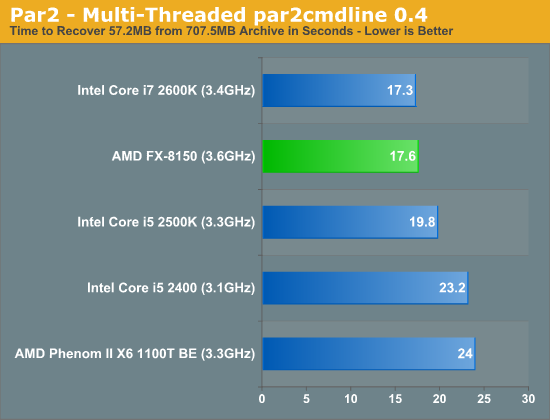
Once again, throw more threads at the processor and the FX-8150 can outperform the Core i5 2500K.
TrueCrypt Benchmark
TrueCrypt is a very popular encryption package that offers full AES-NI support. The application also features a built-in encryption benchmark that we can use to measure CPU performance with:
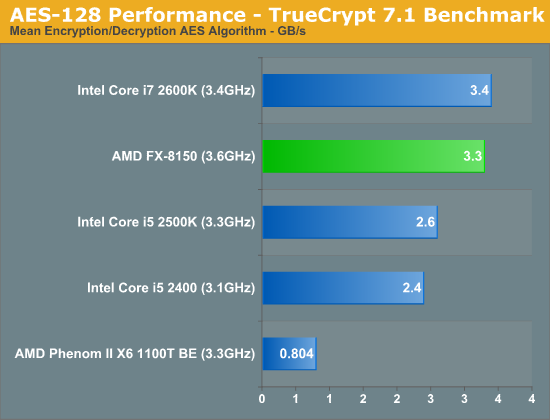
Bulldozer adds AES-NI acceleration, a feature that wasn't present in the Phenom II X6. As a result the FX-8150 is among the fastest at real time AES encryption/decryption, second only to the 2600K. Intel's artificial segmentation using Hyper Threading comes back to haunt it here as the 2500K is significantly slower than the 8-threaded beast.
x264 HD 3.03 Benchmark
Graysky's x264 HD test uses x264 to encode a 4Mbps 720p MPEG-2 source. The focus here is on quality rather than speed, thus the benchmark uses a 2-pass encode and reports the average frame rate in each pass.
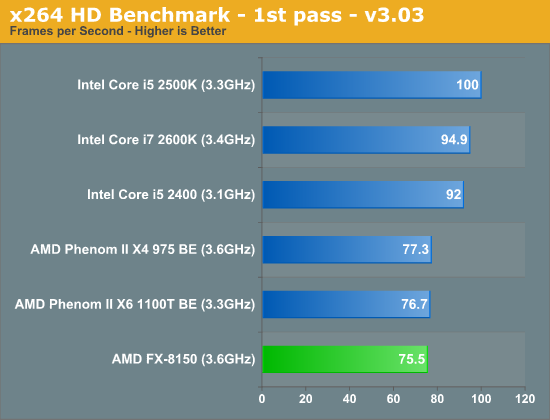
As I mentioned earlier, the first pass of our x264 HD benchmark is a lightly threaded task. As such, the FX-8150 doesn't do very well here. Even the old Phenom II is able to inch ahead of AMD's latest. And Sandy Bridge obviously does very well.

The second pass is more thread heavy, allowing the FX-8150 to flex its muscle and effectively tie the 2600K for first place.
AMD also sent along a couple of x264 binaries that were compiled with AVX and AMD XOP instruction flags. We ran both binaries through our x264 test, let's first look at what enabling AVX does to performance:
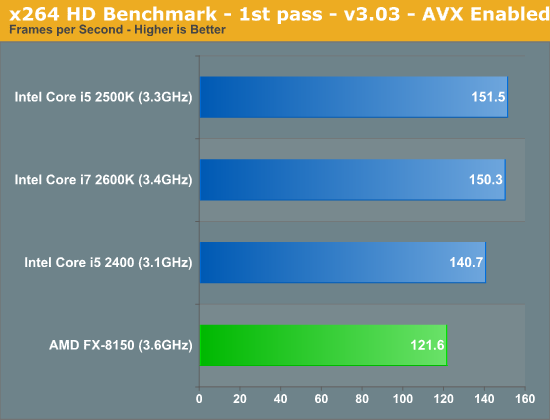
Everyone gets faster here, but Intel continues to hold onto a significant performance lead in lightly threaded workloads.
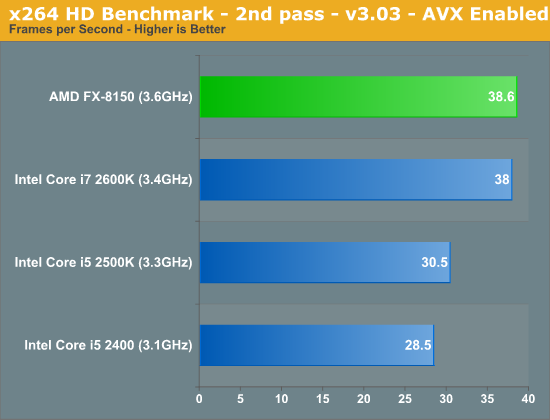
The standings don't change too much in the second pass, the frame rates are simply higher across the board. The FX-8150 is an x86 transcoding beast though, roughly equalling Intel's Core i7 2600K. Although not depicted here, the performance using the AMD XOP codepath was virtually identical to the AVX results.
Adobe Photoshop CS4
To measure performance under Photoshop CS4 we turn to the Retouch Artists’ Speed Test. The test does basic photo editing; there are a couple of color space conversions, many layer creations, color curve adjustment, image and canvas size adjustment, unsharp mask, and finally a gaussian blur performed on the entire image.
The whole process is timed and thanks to the use of Intel's X25-M SSD as our test bed hard drive, performance is far more predictable than back when we used to test on mechanical disks.
Time is reported in seconds and the lower numbers mean better performance. The test is multithreaded and can hit all four cores in a quad-core machine.
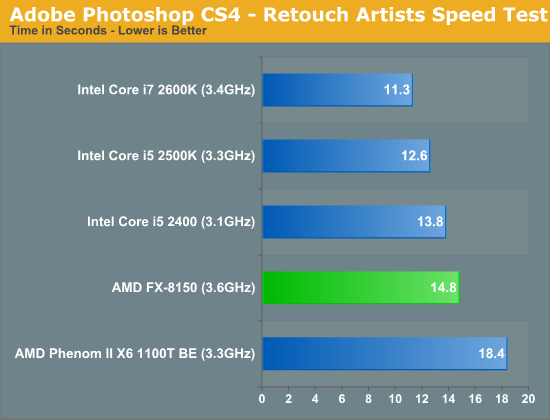
Photoshop performance improves tangibly over the Phenom II X6, unfortunately it's not enough to hang with the enthusiast Sandy Bridge parts.
Compile Chromium Test
You guys asked for it and finally I have something I feel is a good software build test. Using Visual Studio 2008 I'm compiling Chromium. It's a pretty huge project that takes over forty minutes to compile from the command line on a dual-core CPU. But the results are repeatable and the compile process will easily stress more than 8 threads on a CPU so it works for me.
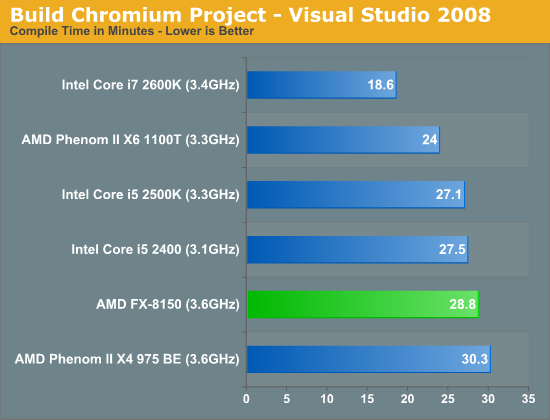
Our compiler test has traditionally favored heavily threaded architectures, but here we found the Phenom II X6 1100T to offer a tangible performance advantage over Bulldozer. While AMD is certainly competitive here, this is an example of one of those situations where AMD's architectural tradeoffs simply don't pay off—not without additional clock speed that is.
Excel Monte Carlo

Our final application test is another win for AMD over the Core i5 2500K. The victory is entirely a result of Intel's Hyper Threading restrictions though, the eight-thread 2600K is able to easily outperform Bulldozer. Either way, AMD delivers better performance here for less money.










430 Comments
View All Comments
TekDemon - Wednesday, October 12, 2011 - link
Yeah I paid $179 for my i5 2500K and it hums along at 4.8Ghz (can hit 5Ghz+ but I wanted to keep the voltages reasonable). Clock for clock bulldozer is slower since it's only competitive when the higher clocked part is compared to a stock 2500K.jleach1 - Friday, October 21, 2011 - link
Their cores offer, what 75% the speed of a normal core?The fact is, this supposed "8" core processor performs worse than AMDs own 6 core processor. There's no way we can get away with calling it an 8 OR a 6 core.
For all intents and purposes, it's a quad core.
estarkey7 - Wednesday, October 12, 2011 - link
You took the words right out of my mouth! I am a big AMD fanboy, and I was waiting with baited breath to jump on the bulldozer bandwagon for my next rig (and I probably still will). But this is ridiculous! I'm a computer engineer and where the hell were the simulations AMD? Seems like you could have halved the L3 and kept in the extra FP resources and been better than what you are doing now.Also, don't bitch about that Windows 7 doesn't realize the architecture of Bulldozer, you knew that 18 months ago, so you should have been writing a patch so that would have been a non issue.
The absolutely, positively only reason i will by an 8150-FX is that my current desktop is a dual core Athlon running at 2.2GHz. So to me, the performance increase over my current desktop would be massive. But on second thought, if I have stuck with such a slow system this long, I might another 3-5 months for Piledriver.
Taft12 - Wednesday, October 12, 2011 - link
<i>The power consumption is absolutely through the roof -- unacceptable for 32nm, really!</i>Uhh, you did see the bar graph for idle power usage, right? And keep in mind this is an 8-core CPU compared to 4- and 6-core competitors.
Like you, I'm also very interested in the 4- and 6-core Bulldozers. Anand let us down by only reviewing the flagship Llano. Hopefully he doesn't do the same with Bulldozer.
Tom Womack - Wednesday, October 12, 2011 - link
Yes, the idle power is significantly worse than either of the Sandy Bridge platforms he's comparing it toJasperJanssen - Wednesday, October 12, 2011 - link
What Anand reviews is mostly down to what AMD will let him have -- even sites the size of Anandtech don't simply get to call and order parts from a catalogue for review samples.Taft12 - Wednesday, October 12, 2011 - link
AMD doesn't have much control over "review samples" that can be purchased at retail, as you can do with the A4-3300 et al. for weeks nowenterco - Wednesday, October 12, 2011 - link
I read that 'at 1920x1200/1080 the gaming performance depends much mure on the GPU. Anyway, I'm happy with my i5-2500k ;-), Bulldozer does not seem to worth the wait.ninjaquick - Wednesday, October 12, 2011 - link
Blame shitty game developers.AssBall - Wednesday, October 12, 2011 - link
Kinda what I was thinking. When they are all developing games for a 6 year old 3 core PowerPC system with 512MB RAM (xbox) instead of a computer, its no bloody wonder.